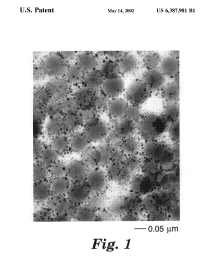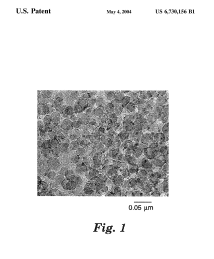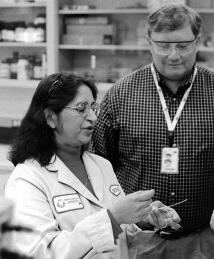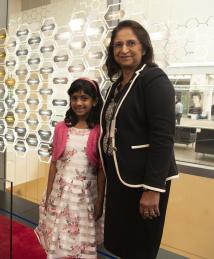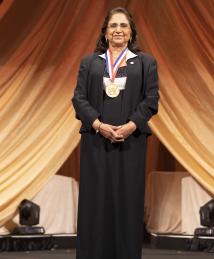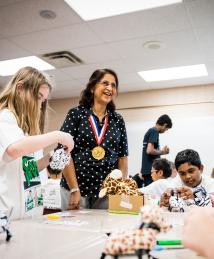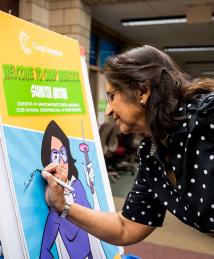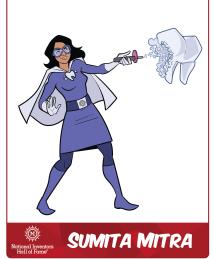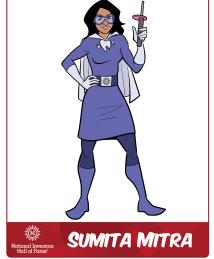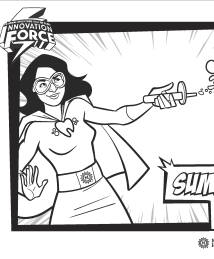Sumita Mitra
"Curiosity and exploration are the essential starting points of innovation. Without those two, nothing really begins. So, we have to cultivate that in ourselves, and in young children, because that’s where it starts."
Sumita Mitra invented the first dental filling material to include nanoparticles – Filtek™ Supreme Universal Restorative. This strong, versatile material gives the appearance of natural teeth and can be used to restore teeth in any area of the mouth.
Born in India in 1949, Mitra has known the value of curiosity and exploration since childhood. In an interview with the National Inventors Hall of Fame® she said, “In the northeast frontiers of India, [...] I grew up in these beautiful surroundings, and I had plenty of time to explore, observe, imagine and be curious about all the different things around me.”
Some of Mitra’s earliest experiences with science and industrial processes took place during her visits to the woodworking factory where her father managed research and development, and oversaw the production and manufacturing lines. Watching the workers turn lumber into useful products made a lasting impression on her. “That stayed with me, that just doing science is not the end in itself. One has to make it into a process that can produce a product that will be useful,” she said.
After earning her bachelor’s degree in chemistry from India’s Presidency College, and her master’s degree in organic chemistry from the University of Calcutta in 1972, Mitra planned to continue her education in the U.S. Her mother, who had homeschooled her for part of her childhood and emphasized the importance of being persistent to overcome obstacles, encouraged her plans.
“It wasn’t common in those days for an unmarried woman to take off and come half the world away to study,” she said. “But [my mother] said, ‘If that’s what you want to do, go for it.’” Mitra did just that, earning her doctorate in organic/polymer chemistry from the University of Michigan in 1977.
In 1978, Mitra began working for 3M as a senior chemist, and in 1983, she joined what was then a fledgling division now known as 3M Oral Care, one of the largest and most profitable businesses of the company. Here, in the 1990s, she and her multidisciplinary team looked beyond traditional dental materials technologies to produce a new material. They developed unique nanomeric and nanoclustered filler particles and combined them to generate a composite system that had excellent paste handling properties and, when cured, provided superior optical properties both initially and long term, as well as mechanical strength.
Mitra described FiltekSupreme Universal Restorative as incorporating “lasting beauty and longevity.” It offered many improvements over standard composites, including versatility of use, ability to withstand fracture, low shrinkage during curing, better polish retention and exceptional wear resistance. The tooth-colored composite would allow dentists to preserve more of a patient’s natural tooth structure while avoiding the health and environmental concerns associated with amalgam fillings containing mercury. It was also attractive enough to fill front teeth and strong enough for all teeth, even molars, which exert heavy chewing pressure.
The product’s first generation was launched in 2002, followed by the second generation in 2005. In 2012, 3M Oral Care launched the third generation, Filtek Supreme Ultra. Since its initial launch, the product line has been used in more than 1 billion restorations worldwide.
Mitra holds more than 100 U.S. patents and their international equivalents. In 1998, she was elected into 3M's Carlton Society, the highest 3M award given for lifelong contributions to research and development. Her inventions have led to breakthrough dental technologies including nanocomposites, resin-modified glass ionomers and dental adhesives. Products resulting from her work include Viteremer™ and Vitrebond™ Resin-Modified Glass Ionomers, RelyX™ Luting Cements, Scotchbond Multipurpose™ Adhesive and APC™ Orthodontic Bracket Adhesive. In 2009 she was recognized as a “Hero of Chemistry” by the American Chemical Society.
After more than 30 years with 3M, Mitra retired in 2010. She is now a professor at the University of South Florida’s Institute for Advanced Discovery & Innovation, and she runs Mitra Chemical Consulting LLC with her husband. A former science coach for the American Chemical Society, she maintains a close relationship with the Minnesota Dental Research Center for Biomaterials and Biomechanics at the University of Minnesota, where she was the industrial director for nearly 10 years. More recently she was awarded the Hollenback Memorial Prize from the National Academy of Dentistry (2020), was elected to the National Academy of Engineering (2021) and as Fellow of the National Academy of Inventors (2021), and received the European Inventor Award (2021).
Mitra remains passionate about encouraging the next generation. “I try to impress upon students that it will give you satisfaction all your life to be doing something that is useful,” she said. In addition to serving as a Collegiate Inventors Competition® Judge, she has made personal visits to Camp Invention® program sites, inspiring young innovators to explore, create and make a meaningful difference. “Curiosity and exploration are the essential starting points of innovation,” she explained. “We have to cultivate that in ourselves, and in children, because that’s where it starts.”
